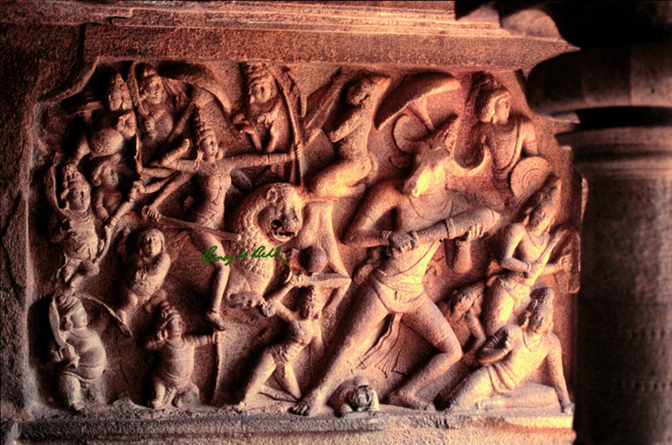The masterpiece of Mamallapuram

Benoy K Behl
Perhaps the most favourite subject of the early Indian sculptor is Durga as Mahishasurmardini where she kills the demon of ignorance in the form of a mahisha or buffalo. The depiction of her in a 7th century cave at Mamallapuram is one of the finest jewels of Indian art.
In Indic thought, the only evil is that of our own confusion, or lack of knowledge of the truth. Deities such as Shiva and Durga are shown attacking and vanquishing the demons of our ignorance. The battle of Durga and the mahisha is one such depiction of the victory of knowledge over ignorance. She represents the vigour and energy within us, with which we would dispel our worldly illusions.
This is an animated scene on the Mamallapuram cave wall and, unlike earlier depictions of this subject, here the scale is naturalistic. The demon has a human body and the head of a buffalo. The natural poses of the figures, advancing from one side and pulling back on the other, enhances the drama and realism of the subject.
The self-assured ganas of Durga’s army of righteousness are unforgettable.
Mamallapuram, also known as Mahabalipuram, is a town in Chengalpattu district in the southeastern Indian state of Tamil Nadu, best known for the UNESCO World Heritage Site of 7th- and 8th-century Hindu Group of Monuments at Mahabalipuram. It is one of the famous tourist sites in India. The ancient name of the place is Thirukadalmallai.
Mamallapuram was one of two major port cities in the Pallava kingdom. The town was named after Pallava king Narasimhavarman I, who was also known as Mamalla. Along with economic prosperity, it became the site of a group of royal monuments, many carved out of the living rock. These are dated to the 7th and 8th centuries: rathas (temples in the form of chariots), mandapas (cave sanctuaries), the giant open-air rock relief the Descent of the Ganges, and the Shore Temple dedicated to Shiva. The contemporary town plan was established by the British Raj in 1827.

